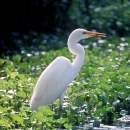Featured Species
At Currituck National Wildlife Refuge, the fish and wildlife species and the habitats are closely connected to each other and the distance from the ocean and the sound, soils, shallow water tables, and flooding frequency on the refuge. The different wetland habitats on the refuge support different suites of wildlife species. Some species, such as white-tailed deer, range over the entire refuge. Other species, such as the secretive marsh birds, are very particular about residing exclusively in brackish marshes. Most waterfowl species only reside in the refuge’s marshes and most soil vegetation units during migration. Colonial nesting birds nest on exposed soil close to the water. Shorebirds reside on beaches and drained moist soil units. Songbirds and rabbits occupy in the refuge maritime scrub shrub community. Ospreys and bald eagles nest in the tops of trees that have been killed by lightning and are located near open water so they can catch fish close to their nests.



